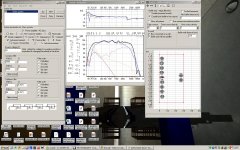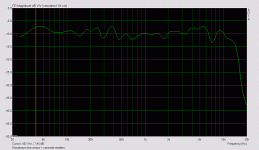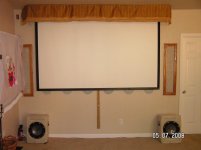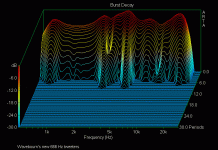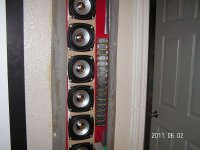Andy G said:
Wouldn't the output (assuming relative box size and porting) justbe the same curve as produced by a single driver in WinISD,
Well that's exactly what I initially thought ("the bass response of ten 6.5" woofers is the same as just one isn't it?"). Maybe I should have said "frequency response".
How far away do you have to sit from these things?
This: Monacor Lightning changed my view on DIY when I heard it. The sound reproduction is just so 'different'.
Maybe it is not a 'perfect' Line Array in 'theory' as technocrats will say, but it works very well and is the best speaker I've heard so far (there were many). It will need a good dynamic subwoofer per side, I'd say till 200Hz but it will go lower.
-Micha
Maybe it is not a 'perfect' Line Array in 'theory' as technocrats will say, but it works very well and is the best speaker I've heard so far (there were many). It will need a good dynamic subwoofer per side, I'd say till 200Hz but it will go lower.
-Micha
Sorry to bring this thread back up. Jim, I registered specifically to email you, but it won't let me.
I'd love to have the plans for these line arrays, can you email me?
Were you able to get an answer from Jim . Can you please share. Please pm me
.
Last edited:
I have received several messages from members requesting plans for the Linus line array design which dates to the early 2000's. Unfortunately the woofers used in this design are discontinued and no longer available. Hence, the original design can not be duplicated without major rework and crossover changes. My friend Rick Craig at Selah Audio does have more current line array designs which may be of interest. Several of Rick's designs use more expensive drivers but some of his projects use less costly woofers and tweeters. Perhaps he can satisfy your needs.
Jim
Jim
Last edited:
Aside from Jims reluctance to support an old design(to much work for him to start over again with a new driver and answer questions all over again... I understand) there is a BSC question? I never got this one answered either???
If during long wavelength excursions, the line array boosts the 1 demensional directional wavefront of such low freq.s, in the vertical, then we no longer have a point source FR of -6db for BSC reasons, we only have -3db. Is not this thoery correct??? Due to the the 1 Demensional propagation baffle step is 1/2 the typical point source speaker behaviour's power response???
If during long wavelength excursions, the line array boosts the 1 demensional directional wavefront of such low freq.s, in the vertical, then we no longer have a point source FR of -6db for BSC reasons, we only have -3db. Is not this thoery correct??? Due to the the 1 Demensional propagation baffle step is 1/2 the typical point source speaker behaviour's power response???
it means les loss of SPL when doubling the distance, this is the main reason for a line array at least in pa. will save you twice the amplifier power. and les of the sound ends up going up and down but just where you want it midel and left and right of the speakers. so in room it has les reflections, wich is also good
Line Array enthusiasts are invited to take a look at my Corner Line Array DIY project. I have lots of detailed measurements and design discussion. Here is a link to the project's home page:
The Murphy Corner-Line-Array Home Page
Here is a sketch of the top view of the system showing the enclosure in combination with its corner reflections:
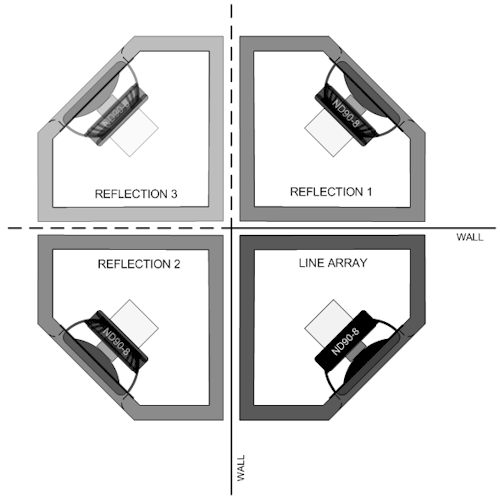
There is a discussion of the image analysis method along with detailed image anaylsis of the corner line array system.
All comments and discussion are welcome.
Regards,
John
The Murphy Corner-Line-Array Home Page
Here is a sketch of the top view of the system showing the enclosure in combination with its corner reflections:

There is a discussion of the image analysis method along with detailed image anaylsis of the corner line array system.
All comments and discussion are welcome.
Regards,
John
I've been there and never quite got my head around all the explaination. Or at least how all the bad things won't be happening with a config like that. I am willing to change from the simple box speaker, and even to try the Roger Russel type design, but, I've been studying the OB theories and I'm more interested in trying to get a hybrid something (OB Line Array) like that running. I'm probably thinking more of a dipole but if it dosen't work, it's an easy job to modify the baffle further or go back to a box.
Why have I not seen anyone trying the Murphy Corner Line Array? It's not that OB line arrays are all that poplular either but???

Why have I not seen anyone trying the Murphy Corner Line Array? It's not that OB line arrays are all that poplular either but???

I've tried ob line array - it was good but not great remember that you still need to supply bass as most mids are rolling off around 500hz. You will also have the secondary issue of dealing with supposed combing etc (this was not a problem I personally encountered). After a lot of playing around with both prototype and modelling sofware I arrive at a pretty regular 3 way ob.
This is not to detract from the benefits of line arrays. I'm building a 7.2 home cinema system and am using 9 4" midrangers per speaker along with a row of 1" tweeters from 80hz up in a tline arrangement.
The attached pic shows the simulation of the midrange at 3m distance measuring pretty flat from 80 to 6.5khz and approx 105db at around 2/3 xmax
please take not that these are against a wall - the baffle is only 23cm from the wall however they will be flush mounted in the wall eventually.
This is not to detract from the benefits of line arrays. I'm building a 7.2 home cinema system and am using 9 4" midrangers per speaker along with a row of 1" tweeters from 80hz up in a tline arrangement.
The attached pic shows the simulation of the midrange at 3m distance measuring pretty flat from 80 to 6.5khz and approx 105db at around 2/3 xmax
please take not that these are against a wall - the baffle is only 23cm from the wall however they will be flush mounted in the wall eventually.
Attachments
good choice of driver size i think reminds me of Keeles choice of drivers. I hunted around for small mids such as your laptop ones but couldnt find anything so i bought a box of piezo's from Apex jr. I also have 400 samsung 4" X 2" high Qts mids from computer monitors that i have modelled for open baffle mid line arrays or possibly to have a play with ambisonics.
So many ideas so little time
So many ideas so little time
I hunted around for small mids such as your laptop ones
Do you mean tweeters?
I've been there and never quite got my head around all the explaination. Or at least how all the bad things won't be happening with a config like that. I am willing to change from the simple box speaker, and even to try the Roger Russel type design, but, I've been studying the OB theories and I'm more interested in trying to get a hybrid something (OB Line Array) like that running. I'm probably thinking more of a dipole but if it dosen't work, it's an easy job to modify the baffle further or go back to a box.
Why have I not seen anyone trying the Murphy Corner Line Array? It's not that OB line arrays are all that poplular either but???

Hi flg,
Thanks for taking a look at my corner line array project.
I understand your concern that bad things happening. The much dreaded comb filtering always seems to come up when line arrays are mentioned. But that is not a problem compared to the alternative of point sources in a room and placed away from the walls. Actually, it is not a problem at all because even though it appears in simulations and is seen in high resolution acoustic measurements, it is completely inaudible where the listener is in the near field of the array (everywhere in the room!). The explanation lies in the realm of psychoacoustics and how the ear fuses all sound events arriving within a small time period into one single but louder sound event.
To date the most popular approach to understanding sound in rooms has been modal analysis...where we compute the room resonance modes and note that the response will be boosted/cut at certain frequencies and/or room locations. However I find there is a more intuitive way to view the room effect that is just as valid as modal analysis but is more intuitive and leads to a different take on speaker placement in rooms. I'm talking about the image analysis where we view the room problem in terms of reflections just as they would be seen with a mirror. Image analysis of a speaker in a room leads immediately to the "impulse response" of the system as we consider each reflection delay and stack it up its impulse along with the direct sound and other reflections that make up the net impulse response.
Realizing how the impulse response changes with speaker placement leads a designer to different placement decisions than modal analysis. In my case, from just a top view sketch of the line array in the room I immediately saw the enormous benefit of corner placement of a small width line array. The line speaker and its corner reflections can be adjusted from being widely separated in time to being more nearly coincident in time by moving the speaker against the wall or even better, into the corner. This groups all the individual components of the impulse response as tightly in time as the speaker-room system will allow. Moving the array out of the corner separates the components of the impulse response in time and my move some out of the "fusion" zone so that they begin to be heard separately from the primary impulse cluster and cause perceived coloration. The time smear outside the fusion zone due to poor room placement leads to undesirable effects such as audible frequency response anomalies that change with your position in the room.
When you apply image analysis to any speaker/room system it can open your eyes with respect to speaker placement in ways that modal analysis fails to do. We all see an occasional nod to "floor bounce" (a reference to the first floor reflection) but largely the other five surfaces of the room are ignored because we have not had an easily understandable way to describe the effect of the room on the overall response heard by the listener. I think image analysis goes a long way toward shedding much needed light on the speaker-room problem. The speaker-room interface seems to be the final frontier of loudspeaker design and is responsible for the largest remaining deviations from the designer's intended system response.
Here is a link to my project references page with links to formal acoustics literature on the image method:
The Murphy Corner-Line-Array Technical References and Links
My corner-line-array project has been sort of a slow burner most likely because I have deliberately NOT written on "how they sound". I prefer instead to publish my carefully made measurements to demonstrate their performance capabilities. I will say this. At this time they are my most trusted monitors and I would not be willing to replace them with any production loudspeaker.
Regards,
John
Nice job Wavebourn. Are the fostex speakers mounted on a shallow curved baffle. It kinda looks that way in the photo. Is there any weighting to the various units?
jamikl
No weighting, but a bit shallow (tweeters).
The much dreaded comb filtering always seems to come up when line arrays are mentioned. But that is not a problem compared to the alternative of point sources in a room and placed away from the walls. Actually, it is not a problem at all because even though it appears in simulations and is seen in high resolution acoustic measurements, it is completely inaudible where the listener is in the near field of the array (everywhere in the room!).
100% true.
Last edited:
Here you go... Such tweeters sound less colored than ribbons, and horizontal directionality is wide. No such thing as "Sweet Spot" with such speakers.
maybe your ribbons ..........
- Status
- This old topic is closed. If you want to reopen this topic, contact a moderator using the "Report Post" button.
- Home
- Loudspeakers
- Multi-Way
- Proven DIY Line Array Design?
